The Greenhouse is an applicant tracking system and recruiting application that helps organizations find suitable candidates, conduct effective interviews, and make hiring decisions more efficiently.
Greenhouse APIs and Schemas:
Harvest API is used to export recruitment information about candidates, jobs, and organizations to access candidate, job, and interview data and perform the following actions:- Update candidate information.
- Add attachments to candidate profiles.
- Accept or Reject candidate profiles.
Candidate API is an API under Harvest that retrieves the candidate details such as Email IDs, Employment Details, and Education Details.
Business Intelligence Connector (BIC) schema consists of a candidate's recruitment and onboarding data.
OvalEdge uses the Greenhouse REST API to connect to the data source and allows you to Crawl, Profile data objects (Schemas, Tables, Table Columns, etc.), and build Relationships.
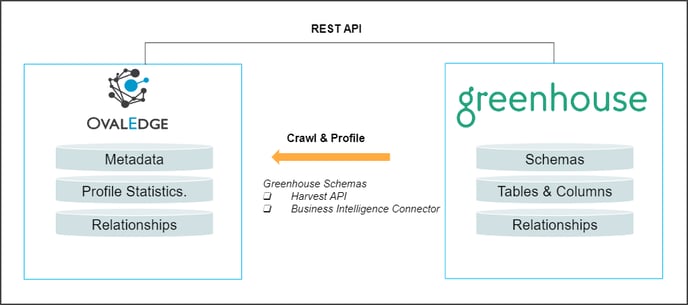 Connector Capabilities
Connector Capabilities
| Functionality | Supported Data Objects |
| Crawler | Schemas, Tables, Columns, Relationships |
| Profiler | Table Profiling: Row count, Columns count, and View sample data View Profiling: Row count, Columns count, View sample data Column Profiling: Min, Max, Null count, distinct, top 50 values Full Profiling |
Prerequisites
The following are the prerequisites required for establishing a connection between the connector and the OvalEdge application.
- Set up API Key.
- Set up a Service account with proper permissions to the Rest APIs of Greenhouse.
- Configure environment variables (Optional).
Set up API Key
OvalEdge uses REST API to connect to Greenhouse.
| API | Version | Details |
| REST API | Okhttp client's Latest version is 4.10.0. | https://mvnrepository.com/artifact/com.squareup.okhttp3/okhttp/4.10.0 |
Note: The API key must be generated from Greenhouse and entered into the configuration setting in OE for the connector to be successful. For generating the key in Greenhouse, refer to the Section How to Generate API Key.
Service Account with Minimum Permissions
The following are the minimum privileges required for a service account to crawl and profile the data.
| Operation | Minimum Access Permission |
| Connection Validation | GET request access for Candidate API |
| Crawling | Read access to API Key, which was created under Harvest API. |
| Profiling | Read access to API Key, which was created under Harvest API. |
Establish Environment Variables (Optional)
This section describes the settings or instructions that you should be aware of prior to establishing a connection. If your environments have been configured, skip this step.
Configure Environment Names
The Environment Names allow you to select the environment configured for the specific connector from the dropdown list in the Add Connector pop-up window.
You might want to consider crawling the same schema in both stage and production environments for consistency. The typical environments for crawling are PROD, STG, or Temporary, and may also include QA or other environments. Additionally, crawling a temporary environment can be useful for schema comparisons, which can later be deleted, especially during application upgrade assistance.
Steps to Configure the Environment
- Navigate to Administration | Configuration.
- Select the Connector tab.
- Find the Key name “connector.environment”.
- Enter the desired environment values (PROD, STG) in the value column.
- Click ✔ to save.
Establish a connection
To establish the connection, complete the following steps:
-
Log into the OvalEdge application.
-
In the left menu, navigate to the Administration module, and click on Connectors.
-
Click on the + icon (New Connector), the Add Connector pop-up is displayed.
-
Search/Click on the desired connector and the Add Connector pop-up with the connector details is displayed.
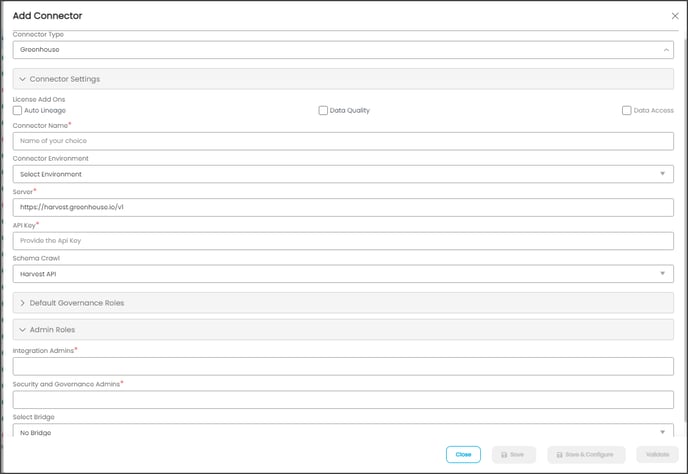
|
Fields |
Details |
|
Connection Type* |
The selected connection type ‘Greenhouse’ is displayed by default. If required, the dropdown menu allows you to change the connector type and based on the selection of the connection type, the fields associated with the selected connection type are displayed. |
|
License Add-Ons* |
All the connectors will have a Base Connector License by default that allows you to crawl and profile to obtain the metadata and statistical information from a datasource. OvalEdge supports various License Add-Ons, based on the connector’s functionality requirements.
|
|
Connection Name* |
Enter a Connection name for Greenhouse. You can specify a connection name to identify the Greenhouse connection in OvalEdge. Example: Greenhouse_db |
|
Environment* |
The environment dropdown menu allows you to select the environment configured for the connector from the dropdown list. For example, PROD, or STG (based on the configured items in the OvalEdge configuration for the connector. environment). The purpose of the environment field is to help you identify which connector is connecting what type of system environment (Production, STG, or QA). Note: The steps to set up environment variables in explained in the prerequisite section. |
|
Server* |
This is the hostname or IP address of the Harvest API endpoints. The base URL for the Harvest API is "https://harvest.greenhouse.io/v1", and you can append the specific endpoint path to this base URL to access the desired endpoint. https://harvest.greenhouse.io/v1/candidates |
|
API Key |
Enter the API Key generated in your API Prerequisite steps. |
|
Schema Crawl |
You can select Schema Crawl from the dropdown menu below, Greenhouse supports two schemas to crawl. Harvest API: The purpose of Harvest API is to fetch recruitment details such as Candidate, Job, and Organization information. Business Intelligence Connector (BIC): The purpose of the BIC connector that contains the recruiting and onboarding data for analysis and reporting. Note: To crawl both the API and the BIC in Greenhouse, you will need to set up two separate connectors. |
|
Default Governance Roles* |
You can select a specific user or a team from the governance roles (Steward, Custodian, Owner) that get assigned for managing the data asset. Note: The dropdown list displays all the configurable roles (single user or a team) as per the configurations made in the OvalEdge Security | Governance Roles section. |
|
Admin Roles |
Select the required admin roles for this connector.
|
|
Select Bridge |
With the OvalEdge Bridge component, any cloud-hosted server can connect with any on-premise or public cloud data sources without modifying firewall rules. A bridge provides real-time control that makes it easy to manage data movement between any source and destination. For more information, refer to Bridge Overview |
5. Click on the Validate button to validate the connection details.
6. Click on the Save button to save the connection. Alternatively, you can also directly click on the button that displays the Connection Settings pop-up window to configure the settings for the selected Connector. The Save & Configure button is displayed only for the Connectors for which the settings configuration is required.
Note: * (asterisk) indicates the mandatory field required to create a connection. Once the connection is validated and saved, it will be displayed on the Connectors home page.
Note: It is up to your wish to save the connection details first and then validate them, or to validate the connection first and then save it.
Connection Validation Errors
|
S.No |
Error Message(s) |
Description |
|
1 |
Failed to establish a connection, please check the credentials |
Invalid API Key. Enter the API Key which has access to Candidate API. |
If you have any issues creating a connection, please contact your assigned OvalEdge Customer Success Management (CSM) team.
Connector Settings
Once the connection is validated successfully, various settings are provided to retrieve and display the information from the data source. The connection settings include Crawler, Profiler, Access Instruction, and Others.
|
Connection Settings |
Description |
|
Crawler |
The Crawler setting allows you to set the crawling configuration that will collect the metadata and display it in the data catalog. Crawler Settings include: (i) Crawler Options Tables, Views & Columns Relationship (ii) Crawler Rules |
|
Profiler |
Data profiling typically involves collecting statistics about data sources such as:
|
|
Access Instruction |
Access Instruction allows the data owner to instruct others on using the objects in the application. |
|
Business Glossary |
The Business Glossary setting provides flexibility and control over how they view and manage term association within the context of a business glossary at the connector level. |
|
Others |
The Send Metadata Changes Notifications option is used to set the change notification about the metadata changes of the data objects.
|
Note: For more information, refer to the Connector Settings.
The Crawling of Schema(s)
You can use the Crawl/Profile option, which allows you to select the specific schemas that need to be crawled, profiled, or unprofiled. For any scheduled crawlers and profilers, the defined run date and time are displayed to set.
- Navigate to Administrator | Connectors, select the radio button for the particular schema, and click on Crawl/Profile option.
- It allows you to select the specific schemas (Harvest API or Business Intelligence Connector) for the following operations: crawl, profile, crawl & profile, and profile unprofiled. These operations can also be scheduled, as per your need.
- Click on the Run button that gathers all metadata from the connected source into OvalEdge Data Catalog.
Note: For more information on Scheduling, refer to Scheduling Connector
Additional Information
How to generate API Keys
Follow the steps below to generate an API Key that will configure OvalEdge to crawl the schemas (Harvest and Business Intelligence Connector).
Please note that the API key generated once is sufficient for any API used in the Greenhouse schema
- Log into the Greenhouse connector.
- Click the Settings option.
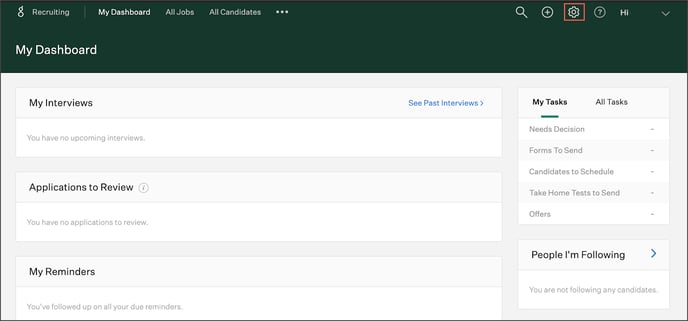
- Click Dev Center and then click API Credential Management.
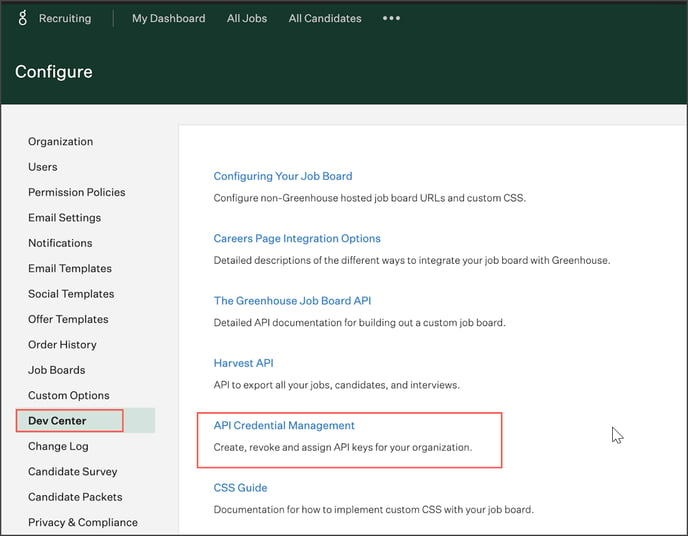
- Click Create New API Key.

- In the Create new credential window, enter a Description for the API key.
- In the API Type drop-down menu, select Harvest, and then click Manage Permissions. API Types are two types - Harvest and Business Intelligence Connector.
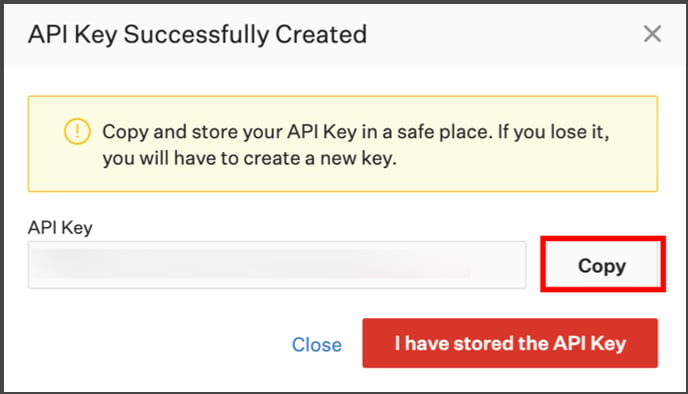
- Click Copy to make a note of the API Key.
- Click Close.
Copyright © 2023, OvalEdge LLC, Peachtree Corners GA USA